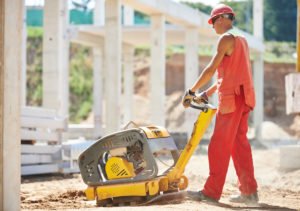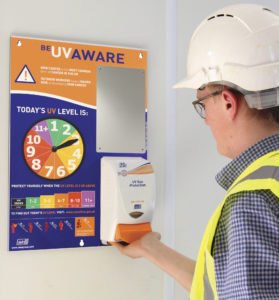According to a recent survey, carried out by SCJ Professional, attitudes towards UV protection remains difficult to change. The results showed that where employers provided sun protection cream, employees used it more frequently, demonstrating the importance of employers providing sun protection for outdoor workers.

Skin cancer is the most common type of cancer in the world. Each year, according to IOSH’s ‘No Time to Lose Campaign’, 1,700 people in Britain alone are diagnosed with it as a direct result of occupational exposure to UV radiation. 60 of these cases are fatal.
Are construction workers aware of the danger of over-exposure to UV? As one of the professions with the biggest portion of time spent working outdoors, the statistics speak for themselves; 44% of occupational melanoma deaths can be attributed to those in the construction sector.
This is a significant concern for the industry, and it is paramount that health and safety professionals recognise this. With occupational dermatitis being an increasingly well-known issue, skin care provisions often focus on this. However, with temperatures rising and the UK seeing hotter summer months, UV protection should be a priority. In fact, last summer was one of the hottest on record with hours of sunshine above average as well, but SC Johnson Professional’s study data suggests that workers’ attitudes to sun protection were not reflective of this.
Protective sun cream
Just one in four outdoor workers surveyed wore protective sun cream during the summer of 2018. Yet with only a small number of respondents aware of the dangers of UV radiation at work, perhaps this is unsurprising. 72% claimed to be unaware that as many as one death and five new cancers per week can be attributed to occupational exposure to UV radiation.
The respondents did know of some of the issues, however. Contrary to a lack of awareness workplace on site, messages about the dangers of UV radiation on holiday have hit home. 87% of the survey’s respondents used sun cream whilst on holiday, showing that awareness campaigns since the 1990s have had an impact on attitudes.
On cloudy days, up to 40% of UV radiation can still filter through, and the majority of respondents were aware of this, yet only 16% would actually wear sun cream on such days. For construction workers, the risk is even higher than the average outdoor worker, with UV radiation reflecting on concrete, grass and soil – fresh snow can even double a person’s exposure to UV.
The above behaviours could have led to a heightened risk of exposure to UV radiation, which in turn means that painful sunburn during one of the hottest summers ever would have been likely. This occurrence just once every two years can triple the risk of malignant melanoma. The above findings suggest an awareness of UV damage to an extent, but a lack of understanding of how serious the resulting health risks have the potential to be. It could be argued that employers have the most potential to influence a behaviour and attitude change when it comes to UV protection.
Legal requirements

UK employers are legally required to ensure that workers do not suffer harm or injury at work. When looking further into this, SC Johnson Professional’s survey revealed that, when employers provided sun protection cream, almost double the number of people used it.
The No Time to Lose Campaign says, the good news is that 90% of all skin cancer deaths could be prevented if sun exposure is controlled. When thinking about PPE, UV protection should be given priority by health and safety policy makers. Now is the time to help raise awareness amongst employees who spend much of their time outdoors, with tools such as free sources, UV level indicators and free product.
It is recommended too that employees adapt the 5 ‘S’ approach to sun safety:
- SLIP on sun protective clothing – Encourage workers to keep covered up. Clothing can be one of the most effective barriers.
- SLOP on sun cream – Apply a broad spectrum, minimum SPF30 sun cream 20 minutes before initial exposure and re-apply every two hours or more frequently if sweating heavily.
- SLAP on a hat and neck protection – Where possible choose a hat with ear and neck protection.
- SLIDE on some sunglasses – Slide on a pair of high-quality wrap-around sunglasses to protect the eyes.
- SHADE from sun where possible – Encourage workers to take breaks or work in a shaded area wherever possible, especially from 11am-3pm.
Find out more information or request a free consultation from one of SC Johnson Professional’s team of specialists, click here.
Why should you subscribe to the SHP newsletter?
Do you want the very latest health and safety news, product launches, job listings and expert opinions sent straight to your inbox daily?
The SHP newsletter is essential reading – sign up today to get your hands on all this!




What a load of old twaddle, it has never bothered construction workers before. Worlds gone soft, sun is no different.